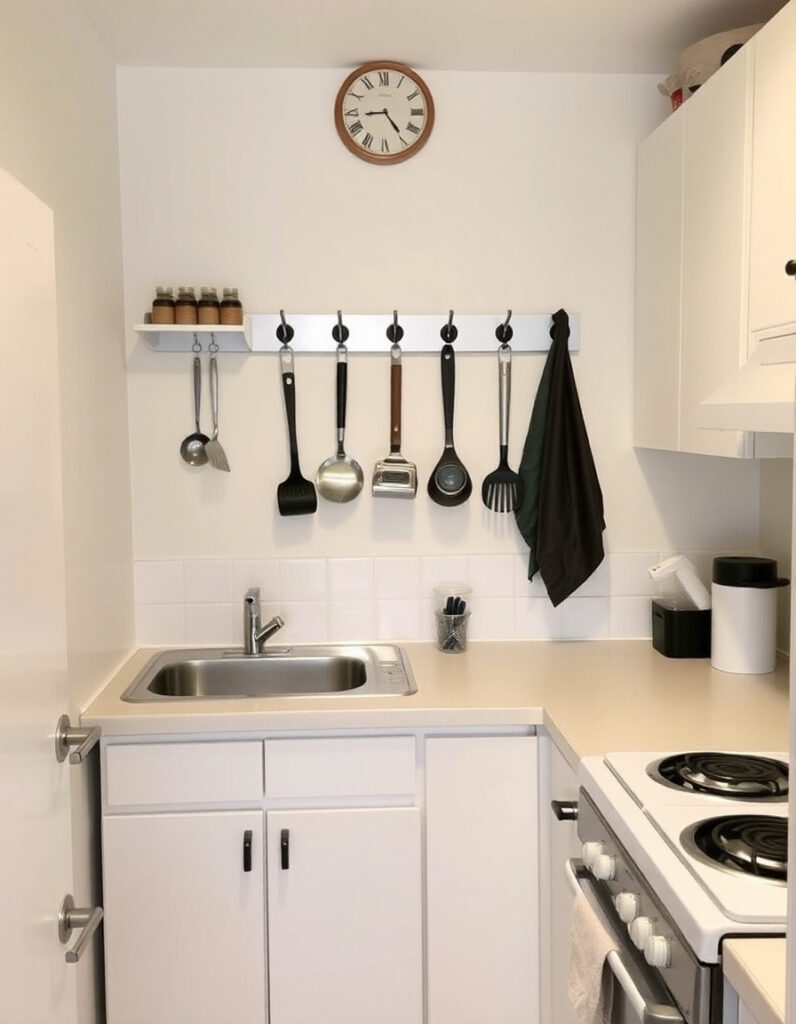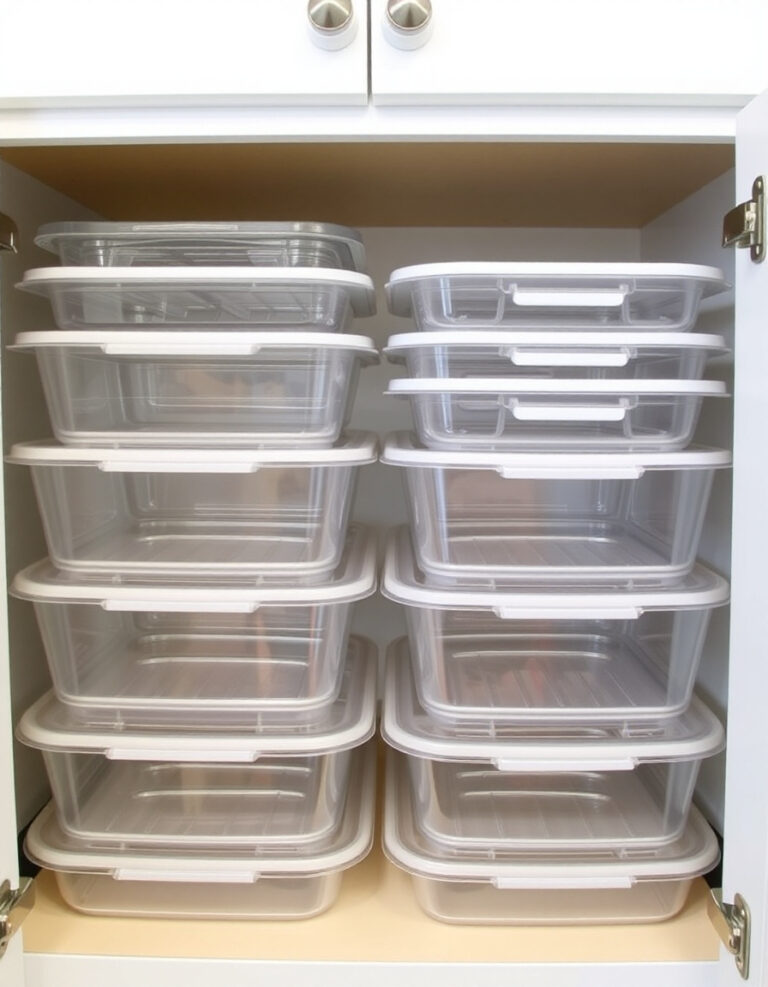Small spaces get messy fast, especially when cooking, eating, and storing everything happens in the same few square feet. The good news is that tiny kitchen cleaning tips don’t have to mean scrubbing surfaces every hour. With the right setup and a few strategic habits, a compact kitchen can stay clean with little effort.
Why Small Kitchen Organization Changes Everything

When every inch matters, clutter doesn’t just look messy—it makes cooking harder. A cramped counter means less prep space, and a crowded sink means dishes pile up faster. The key to minimal kitchen cleaning isn’t doing more work; it’s setting up the space so messes have fewer places to hide and fewer reasons to build up in the first place.
1. Designate One Clear Workspace and Keep It That Way
Choose one section of counter as the permanent prep zone. This spot stays clear at all times. When it’s time to cook, there’s no need to shuffle things around first. A dedicated workspace cuts prep time and prevents the “where do I even start” feeling that makes small kitchen maintenance feel overwhelming. Just keep a cutting board and knife block there if needed, nothing else.
2. Use Vertical Storage to Clear Horizontal Surfaces
Wall-mounted racks, magnetic knife strips, and hanging hooks take advantage of space that would otherwise go unused. Pots, utensils, and dish towels belong on walls or cabinet doors, not on counters. This approach to space-saving cleaning methods means fewer items to wipe around and more visible surface area. The less stuff sitting out, the faster surfaces clean up.
3. Adopt the One-Minute Wipe-Down Rule After Cooking
Right after plating food, use the hot pan time to wipe counters and the stove. Takes about 60 seconds while things are still warm and easy to clean. This single habit prevents the hard, baked-on messes that turn quick cleanups into major scrubbing sessions. A damp microfiber cloth handles most fresh spills without needing spray cleaners.
Also Read: 7 Wall-Mounted Storage Solutions For Cramped Kitchens
4. Store Cleaning Tools Where the Mess Happens
Keep a small caddy under the sink with a sponge, dish soap, and all-purpose cleaner. The easier tools are to grab, the more likely they’ll get used for quick kitchen cleaning instead of waiting for a dedicated cleaning day. Some people stick command hooks inside cabinet doors for spray bottles. The two-second access makes a real difference in whether messes get handled right away or left to harden.
5. Limit Dish Accumulation With a Compact Kitchen Maintenance System
Wash dishes immediately after eating or load them straight into a small drying rack. In a tiny kitchen, there’s no room for a sink full of dirty plates—it blocks the entire workspace. A “clean as you go” approach isn’t just about tidiness; it’s about keeping the kitchen functional.
6. Use Drawer Dividers and Cabinet Bins for Clutter-Free Small Kitchen Storage
Random utensils rolling around in drawers create visual chaos and make it harder to put things back where they belong. Dividers and small bins turn every drawer and cabinet into an organized zone with a specific spot for each item. When everything has a home, efficient kitchen upkeep becomes automatic instead of a constant guessing game about where things go.
Read More: 10 Appliance Storage Solutions For Tiny Kitchens
7. Create a Nightly Reset Routine That Takes Under Five Minutes
Before bed, clear the counters, wipe them down, and make sure the sink is empty. This streamlined kitchen routine means waking up to a clean slate instead of yesterday’s mess. Five minutes feels manageable even on busy days, and the morning payoff makes it worth the effort. A timer can help keep the routine quick and focused.
8. Keep Only the Appliances You Use Weekly on the Counter
Toasters, coffee makers, and blenders take up serious real estate in a small kitchen. If something only gets used once a month, it belongs in a cabinet or pantry. Fewer appliances on display means less surface area to clean around and more room for actual cooking. This is one of the most effective tiny kitchen cleaning tips for visual clarity.
9. Line Shelves and Drawers With Easy-to-Clean Liners
Crumbs, spills, and sticky residue sometimes end up in cabinet corners no matter how careful cooking gets. Removable shelf liners can be wiped down or replaced in seconds instead of scrubbing wood or laminate surfaces. This small change makes deep cleaning cabinets a five-minute task instead of an hour-long project. Look for non-adhesive liners that stay in place but pull out easily.
Read More: How To Keep A Studio Kitchen Organized With Minimal Cabinets
10. Tackle Trash and Recycling Before Bins Overflow
A tiny kitchen can’t hide an overstuffed trash can. Take out garbage and recycling when bins hit three-quarters full, not when they’re spilling over. This prevents smells, fruit flies, and the need to clean up around the bin area. Keep extra bags at the bottom of each bin so there’s always a fresh liner ready to go.
11. Establish Zones for Cooking, Cleaning, and Storage
Even in a compact space, dividing the kitchen into functional zones reduces chaos. Cooking tools near the stove, cleaning supplies under the sink, and dry goods in one designated cabinet. This small kitchen organization strategy cuts down on cross-contamination and unnecessary movement during meal prep. When everything stays in its zone, cleanup happens faster because items don’t migrate across the kitchen.
Common Mistakes That Make Tiny Kitchens Harder to Clean
Skipping the evening reset might save a few minutes at night, but it creates a longer cleanup the next day. Storing too many items on open shelves adds dust and grease buildup that closed cabinets would prevent. Using the counter as a catch-all for non-kitchen items turns a small space into a cluttered surface that’s harder to clean. Sticking to kitchen-only items and daily maintenance prevents these issues before they start.
Frequently Asked Questions About Tiny Kitchen Cleaning Tips
How do you keep a small kitchen from getting cluttered? Limit what stays on counters to daily essentials and store everything else in cabinets or on walls. Assign a specific home for each item so there’s no confusion about where things belong. Regular decluttering—removing expired food, duplicate tools, or unused gadgets—keeps storage spaces from overflowing.
What is the fastest way to clean a tiny kitchen? Start with clearing all surfaces and putting items back in their designated spots. Wipe down counters, the stove, and the sink in one continuous motion using a damp microfiber cloth. Finish by sweeping or spot-mopping the floor, which takes under a minute in a small space.
How often should you clean a small kitchen? Daily quick cleanups (wiping surfaces, doing dishes) keep messes from building up. Weekly tasks include mopping floors, wiping down cabinet fronts, and cleaning out the fridge. Monthly deep cleaning covers oven interiors, behind appliances, and inside cabinets.
What cleaning supplies do you need for a compact kitchen? A good all-purpose cleaner, dish soap, microfiber cloths, a sponge, and a small broom or vacuum handle most tasks. Add a degreaser for stove tops and a disinfectant for cutting boards. Keeping supplies minimal means more storage space for kitchen essentials.
Can you use a small kitchen without it getting dirty immediately? Prep work on a cutting board instead of directly on counters contains messes to one washable surface. Using pot lids while cooking reduces splatter on surrounding areas. Keeping a small trash bowl on the counter during meal prep catches scraps before they hit the floor.
Keeping a Tiny Kitchen Clean Is About Smart Systems, Not More Work
A compact kitchen stays cleaner when the setup makes tidiness the default, not the exception. Strategic storage, quick daily habits, and the right cleaning tools turn maintenance into a manageable routine instead of an overwhelming project. These tiny kitchen cleaning tips work because they focus on prevention and efficiency—two things that matter in small spaces.



